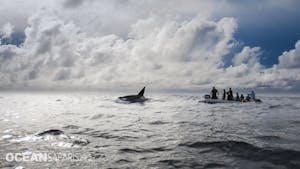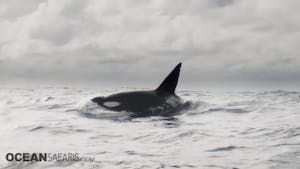Observation of a Predation of a Humpback Whale Calf by two Killer Whales

Observation of a Predation of a Humpback Whale Calf by two Killer Whales (Orcinus Orca)
We observed two male Killer Whales (Orcinus orca) kill and partially ingest 6-7 meter Humpback Whale (Megaptera novaeangliae) near Roca Pardita which is one of the Revillagigedos Islands—more commonly known as the Socorro Islands, Mexico
(18° 59.325 N, 112° 04.519 W)
The following is based on personal observations, field notes, photographs and video documentation of the event.
Caution Graphic Content of Wild Animal Behavior:


At 8:00 on 29 January, 2015 I (JM) spotted a female Humpback, her male calf and a male Humpback Whale escort near Roca Pardita. The Whales had been observed at this location for about 24 hours prior during daylight hours. During the time of observation by SCUBA and free-diving the whales relaxed mid-water with the calf surfacing every few minutes, we did not observe the calf actively feeding but we did observe the calf in a position that one would assume he was trying to feed at one time. during these observation dives the Mother Humpback Whale, Calf and Male Humpback Escort appeared to be heathy. During these SCUBA dives and freedives the Mother would freely move about the divers in close proximity.


At 9:16 after completing an hour long SCUBA dive around the whales, we had returned to the inflatable boats to drop off our tanks. Once on board we were relocating the vessel to enter the water to free dive with the Humpbacks as we had the prior day. At 9:24 (est) just seconds prior to entering the water I (JM) observed a normal blow from the female humpback and then a breach by a Male Orca on the humpback calf. Upon this I additionally observed a gush of blood from the calf.
The Female immediately began aggressive behaviors which included loud and forceful exhalations (trumpeting loudly) and she spun at the surface slashing and slapping of her flukes and flippers.
The Male Escort also arrived within a second and lunged breached upon one of the Orca and continued to slap with its flukes and flippers vigorously trying to defend the calf. The male escort also continued with loud and forceful exhalations.
The Escort and female to continued roll onto the Killer Whales back side first with continued slashing, slapping of pectoral fins and flukes. This extreme activity of the whales slashing, slapping fins lasted for less than three minutes.










At 9:33 the second inflatable arrived onsite with EH. We (JM and EH) continued our observation of the two male Orca and humpback calf from two different Inflatable boats.
At 9:40 once the calf was separated from the other Humpbacks one last long trumpet was heard by the Male Escort as the Male Escort and female swam back closer to the island retreating.
The two Orca positioned themselves on each side of the calf and swam away. Although not confirmed, it appeared that the two Orca may have each had a pectoral fin of the calf in its mouth. as they swam very closely together.
The calf was still breathing, and the Orca slowed.
At 9:47 the Orca continually pushed the calf down into the water and to try to drown it, at the same time taking bites into the body of the calf.
Observed in both the photographs and video you can see portion of the right tail lobe missing from the calf.
Once the calf died the Orca started to skin the humpback, tearing away the skin and folding the skin back to feed on the body. Photographs show the calf skin pulled away from the body and in the video you can observe the Orca feeding on the body. Each time the calf would sink one of the Orca would bring it back to the surface. After a few minutes Approximately 20 Silky Sharks (Carcharhinus falciformis) , 2-4 Silvertip Sharks (Carcharhinus albimarginatus) and perhaps 1 Blacktip Shark (Carcharhinus limbatus) were observer and also started to feed on the humpback carcass. This went on for several minutes with each Killer Whale taking turns feeding which caused the smaller sharks to disperse temporarily from the carcass . Each time the Orca would surface with the carcass we would position ourselves closer to the now dead calf and the Orca would move away with the carcass as if each inflatable was another predator. At 10:39 the Orca moved away allowing the remaining humpback carcass to sink.
Observations of the Humpbacks post attack.
Once the Orca had dispersed the area both the female and escort started to swim in what seemed like a search pattern, going to and from the island in a grid pattern. this continued for the rest of the day light hours.
We additionally observed forceful breathing by both humpbacks. Both Humpbacks swam at an increased speed during these “search pattern swims and dives”
At 12:39 we once again decided to SCUBA dive, we started our dive on the opposite side of the island, underwater very few fish remained of what we previously had observed prior to the predation. Again at 13:21 we seen the whales but at a very high rate of speed (10-12 kt est. ) and they did not yield to the group, instead split the group of divers by forcefully running though the divers.
Up till our 3rd dive of the day at 3:34 we had watched the Humpbacks continue their “search pattern” high speed swim swimming out to more than a mile from the island sometimes breaching and then coming back to the rock. During our 3rd dive we once again seen the whales swimming fast towards us but when they seen us this time they stopped finning and slowly glided past us. During this time, we did not observe any new cuts, wounds to either Humpback. On the female Humpback during observation does not appear to have Orca bites either prior or post predation.
With little life around the island after the predation we decided to depart the island for San Benidicto Island.
Note: during the SCUBA dive directly prior to the predation we had Dolphin swimming with us but the they departed uncharacteristically we all noted that after the fact
Sea State during the predation was 8 kt wind (estimate) with 2-3ft wind waves every 6 seconds from the North. Underwater visibility was 30-40ft+. , 1 knot (estimate) current from north to south water temp 78F approximate
This was filmed by several GoPro cameras several Digital cameras and witnessed by 8 divers in the first inflatable, onsite from start to finish and an additional 12 divers during the feeding part of the predation.
Time of day recorded by JM by use of raw camera data on each image
Boats are Achilles inflatable boats with inflatable keels 7 meters in length with 60 hp motors. grey in color
Killer Whales have yet to be identified but at this time thought to be from the Eastern Tropical Pacific group
Killer Whales have thought to feed on Humpback Whale calves but this has never been documented in Mexico. 25% of all adult Humpbacks have Killer Whale scares on their Flukes.
Killer Whales are not common around the Socorro islands one Solmar V Mariner recounts only one other time he has seen Killer Whales in his 18 years of service on the Solmar V about 14 years ago.
The vessel Solmar V is in the Socorro islands typically Nov – June trip lasting 9-12 days are normal.
The Female Humpback was filmed at Roca Pardita in Jan 18 for 3 trips in 2013 with another calf and a different Male Escort. video is also available of this. In 2015 the Female Humpback was Identified on site prior to any diving by a bump forward of the Dorsal fin on the left side of the animal. Since, the female Humpback has been identified by Happywhale.com Identification experts as CRC-16908 also known as FIBB-2BB116She is known from research conducted by ECOBAC from the photo-identification catalog of humpback whale of Banderas Bay, Mexico (FIBB catalog) First recorded sighting was in 01/22/2006 in Nayarit, Mexico. Sighted in Cabo San Lucas, Mexico 12/25/2017 and the last recorded sighting was 01/25/2019 in Cabo San Lucas, Baja, Mexico




This Socorro islands expedition was lead and hosted by Ocean Safaris Owner / Expedition Leader James Moskito on the Solmar V vessel.
James Moskito (JM)
Ocean Safaris, LLC
dba Safari Monterey
